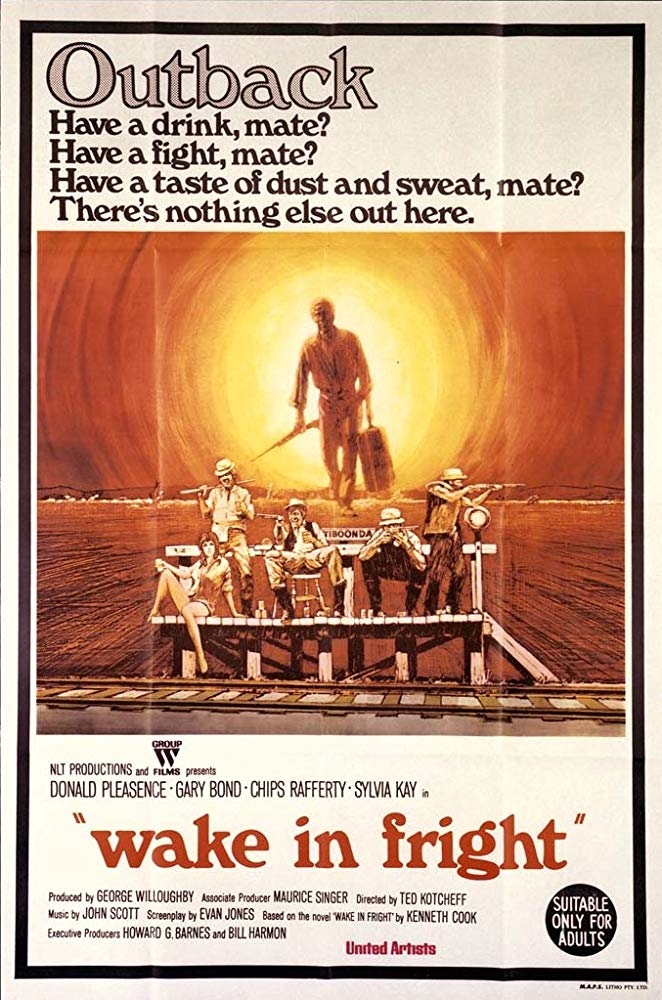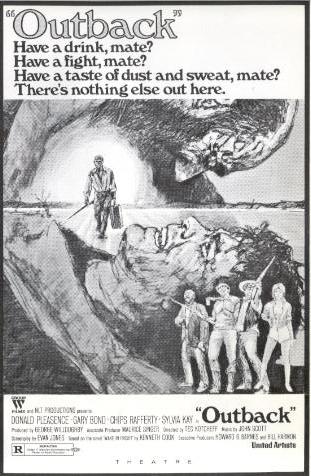

Wake in Fright (Ted Kotcheff, 1971) aka Outback (overseas); wr. Evan Jones, novel Kenneth Cook, dp Brian West, ed. Anthony Buckley; Gary Bond, Donald Pleasance, Chips Rafferty, Sylvia Kay, Jack Thompson, John Meillon
So dark in style that it goes beyond realism, this film, directed by a Canadian, presents a bleak view of life in the more remote parts of Australia (whites only).
David Stratton mentions in his first book (1980: 7; and also in his Autobiography, 2008: 269) that this film was 'almost made' by Joseph Losey, and that if it had been it would have had Dirk Bogarde in the lead. Imagine that: it's already a very good film - it would have been outstanding. Both he and the actor who was cast by Kotcheff (as John Grant) Gary Bond, were gay, so would presumably have been able to deal with the implied homosexual encounter with the character played by Donald Pleasence in one of his two or three trips down under.

Ted Kotcheff (b. Toronto, 1931) has directed as much for TV as on film, as that is how he began his career. Not long after making this film he made First Blood (1982) the first Rambo film.
This was Chips Rafferty's last film, and Jack Thompson's first feature. It's also one the three films Dawn Lake, wife of TV personality Bobby Limb, appeared in. Limb was a major stockholder in NLT, one of the two companies which produced the film. The director's wife, Sylvia Kay, also played a part.
The film premiered at Cannes in May 1971. Pike & Cooper tell us (259) that it was warmly received in both Paris and London, but did less well when it opened later in the year in Australia, perhaps partly because the distributors, United Artists, did not market it effectively. Shirley & Adams suggest that it 'was perhaps too uncomfortably direct and uncompromising to draw large Australian audiences' (245).

John Grant's nadir is definitely the sexual encounter with Pleasence's Doc Tydon (he tries to shoot himself shortly thereafter) so I find it interesting that audiences now are much more horrified by the kangaroo hunting sequence. As I spent many of my school holidays on my uncle's farm, and, as the kangaroo shoots we went on (at night, with the driver's door and all windows on the Land Rover removed) remain the most exciting thing I've ever done, I enjoy those scenes. Those I enjoy least show the bored schoolteacher in his boring classroom. (I was also a schoolteacher.)
What follows is some of the discussion from a website devoted to chatting about Oz railways (railpage.com.au). Thanks to the discussants who identify the location of the shoot of the opening sequence.
I know the scenes at 'The Yabba' station are the old Sulphide St. in Broken Hill but not sure about Tiboonda. And was that type of platform with that clock typical at the time or is it something created for the film?
Having examined the opening scene, where camera pans through 360 degrees, I believe it was filmed at Horse Lake, on the Broken Hill line. In both the film footage and on Google Earth, you can see the remnants of a triangle, which I think was once used for the operation of water trains.
That's quite convincing. As the film was shot in Broken Hill, I've presumed that 'Tiboonda' must have been somewhere between there and Menindee, just for the logistics of filming. The name is obviously a reference to Tibooburra/Milparinka, but, no rail line eh. The remains of the triangle, the roads, and the buildings in the film all match what's visible in Google Earth so Horse Lake seems to be it. Thanks for that.
It was, most certainly, Horse Lake. The film company built a set there which burnt down later on.
I thought that was solved but I've just noticed (thanks to Rolfe's excellent site) that, before 1923, Kinalong (the next station west of Horse Lake) was called 'Horse Lake', and that a look at Google Earth shows the remains of a triangle there as well on the same side of the line. There's also something a bit more substantial in the place where a building is seen in the opening pan shot mentioned initially. Which 'Horse Lake' was it? I'm presuming the 'Horse Lake' Horse Lake. And while I'm at it, that FO we see; I presume it was hanging around Broken Hill at the time, I can't imagine they'd run one out from Parkes just for that one shot. What would it have normally been used for? Surely not the overnight BH - Parkes train that ran at that period.
Tiboonda is, as I have said before, Horse Lake. The triangle you can see faint remains of in the overview shots dates from the 1950s water trains.
The clock is a bit of artistic licence, although the platform may be the real thing. There was a similar platform at Warattah which appeared on the back pages of a number of magazines years ago advertising J&B Scotch (or maybe Benson & Hedges cigarettes).
The FO is in a train that pulls up to the platform so it was out there. It would not have been used on the Horror - No 26 the weekly overnight train from BH to civilisation.
I can't recognise the bar the beer swilling scene was shot in. I always had the idea that it was the Palace Hotel which also starred in Priscilla but I am not sure.
When the schoolteacher goes back to Tiboonda despite the fact that they are obviously waiting at Sulphide St, the train is headed by a 49 class passing a 3 aspect colour light signal.
The bar scene, as I recall, was not the Palace Hotel but a smaller single story establishment at the other end of town. I can't remember which one.
I heard Ted Kotcheff interviewed. He said Tiboonda was created for the movie and filmed outside Broken Hill. I got the impression that the platform was really the only thing there and they just created a sign and stuck it on. Maybe the pub was just a tin shed, it does seem to be bigger on the inside than the outside.
Luke Buckmaster, cinetology, on drunks in movies.
Garry Maddox, 'Film raised from its slumber', SMH, 11 March 2009.
Garry Gillard | New: 17 September, 2012 | Now: 31 December, 2020